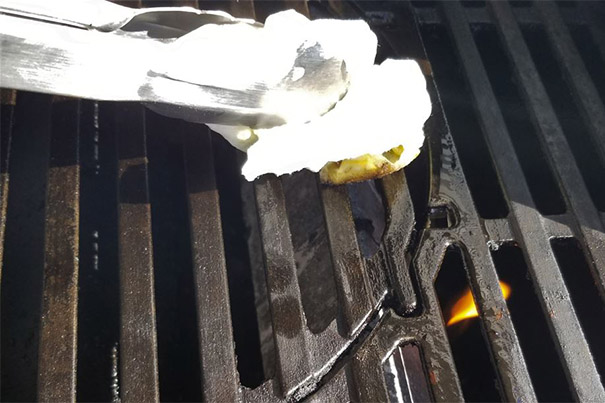How to Stop Food from
Sticking to Ceramic Kamado BBQ Grill?
In this article, you will get proven tips on
how to stop food like meat, fish or poultry from sticking to ceramic
kamado bbq grill so that you will never encounter this
situation again.
Why does food stick to the grill?
The
three biggest reasons food sticks to the grill are:
•
Not hot enough
•
The grate is dirty
•
No oil on the grate or meat
Scientifically speaking, when food sticks, it is because the protein in the meat creates a chemical bond with the metal grates.
Chemical bonds are where molecules share electrons, creating attractive forces like magnets. The principle of tape sticking to the skin is the same.
The meat usually sticks to it at the beginning until it forms a good scorch and grill marks. Another reason for persistence is seasonings and sauces that contain sugar. The sugar burns and becomes carbon attached to the grate.
Here
are some suggestions to reduce or eliminate “gluing” or sticking
during grilling.
Tips to prevent food from sticking to the grill
If you can observe the grill grate under a microscope, you will see pores and rough pit surfaces.
Even a grille plated with nickel or porcelain is not as smooth as it looks to the naked eye.
The
fact is, the rougher the metal, the more likely it is that the food cooked
there will stick. So, what can you do? What should you consider to prevent food
sticking?
How clean is your grill?
The best way to prevent food from sticking is to start with a clean grate.
If you burn the carbon in the barbecue sauce last night, it will be like a food magnet, and the food will stick to it. Always use a scrubbing pad, some rolled foil or a good grill brush to clean your grill, then rinse with clean water before starting.
It
is best to do this while the grill is still hot, or to have time to preheat
after it has reignited from a cool place. It helps release grease.
Use high-smoke point oil
Most cooking websites recommend oiling the grate before grilling to prevent sticking. This is true in many cases. However, you need an oil with a high smoke point. The higher it is, the longer it lasts on the grill.
The smoke point of peanut oil, sunflower oil, corn oil and palm oil is around 450°F or 232°C. Refined canola oil is a good alternative, with a smoking point of 400°F or 204°C.
Once your oil exceeds the smoking point, it will start to become carbon. Adding more oil on top will only produce more of the same effect.
One method of seasoning a grill is the same as the technique of seasoning a cast iron skillet. Simply wipe the grate with oil, heat to temperature, remove the grate and let them cool. Re-oil them and put them back on the grill. This technique should reduce any adhesions.
If
you want to oil the hot grate, just rub two paper towels into a ball, dip them
in the oil, and then rub the oil-soaked paper on the grate with some long
tongs.
Instead of oiling the grill, oiling the meat.
You can combine the above methods with this technique, or you can leave the grill without oil at all.
First,
dry the meat with paper towels and lightly grease it. When you place the meat
on the grill, the oil will fill the metal pits and rough areas, effectively
making it smoother and reducing the chance of food sticking.
How about cooking spray?
If you use cooking spray, use it before ignition.
Most cooking sprays use canola oil, a high-temperature vegetable oil. However, they use the highly flammable butane, isobutane and propane compressed gases as propellants. If you try to spray in the presence of flames, they will become impressive blowtorches. This is dangerous, so don’t do it.
Cooking
sprays can help your grate release food better.
Preheat the meat to cook on its own
Always preheat your grill. When you lie on the meat, you want to hear hiss.
As long as the meat comes into contact with metal, steam will be produced. This helps prevent proteins from binding to metal surfaces.
If you have ever put chicken breast in a cold grate or a cold frying pan and then heated it, then you will know how sticky it is.
The
steam helps release the meat from the grate. Once the moisture evaporates, the
meat will start to brown and leave you with those beautiful crusty grill marks.
Prevent the chicken from sticking to the grill
The same method can be used whether it is peeling or peeling the skin of the chicken.
First pat the chicken dry, season it, and then lightly coat it with olive oil or canola oil.
Place the chicken on the grill, skin side down. This also applies to boneless and skinless chicken breasts, even if they are skinless. Place the chicken with the skin side down. The skin side is smoother and less meat can grab the grate.
If
it still sticks when you turn it, try to cover it for a minute and then try
again.
Prevent the fish from sticking to the grill
Fish is the most delicate protein you can grill. Muscle contains 70% to 80% water, depending on the species, while the water content of skin-on white meat chicken is only 69% or less. If there is no hot grill and no oil is added, the excess water will make the fish stick together.
When grilling fish, the skin is your friend. As mentioned earlier, oil the grate. Another tip is to take the fish out of the refrigerator for about 15 minutes to bring it to room temperature. Cold fish on a hot grill can quickly cool the grate, causing them to stick together.
Brush or rub the two sides of the fish fillet with oil and place the fish skin side down. After two to four minutes, try to lift the fillet with a thin spatula. If it releases, just flip it. If it still sticks. Wait another 30 seconds and try again. When the skin is ready to turn, it usually releases.
The skin is delicious and contains most omega fatty acids. In other words, not everyone likes it. Use the skin as a non-stick shield for the fillets. Use a spatula to gently slide between the meat and the skin. The fish skin will stay on the grate, you can put the other side of the fish directly on the grate or bake it on the back to protect the skin.
The
meat noodles of the fish will be partially cooked and will not stick together
like the first side. Cover the grill and cook until the center of the fillet is
opaque. This will be an internal temperature of 125 °F (52 °C)
The important tip here is to keep your grate very clean, season it with high-temperature oil, oil the meat, and grill it at a higher temperature.
Don’t
forget to be patient and let the grill work. Turning the food too early will
not allow enough time for the meat to be released from the metal.

